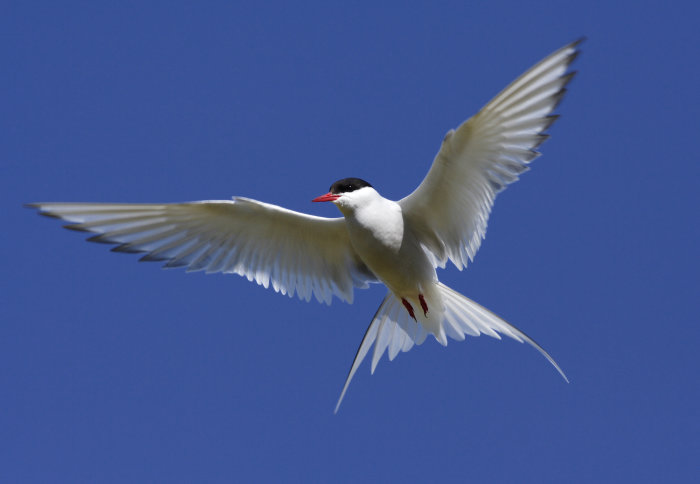45,000 bird wing measurements reveal where the best fliers live

Arctic terns fly from the Arctic to the Antarctic and back again each year
How adapted birds are to flying is linked to their lifestyle and environment, according to new research on the shape of their wings.
By examining the wings of more than 45,000 birds from 10,000 species, researchers have shown that birds living at higher latitudes are more able to disperse – to move over a wide area.
We hope our measures of wing shape for almost all bird species will have numerous practical applications, particularly in ecology and conservation biology. Dr Joseph Tobias
The gradient in average dispersal ability – from low near the equator to high at higher latitudes – was best predicted by whether birds were migratory or how they defended a territory, two factors that are strongly correlated with variability in temperature (seasonality). Birds at low latitudes live in stable climates and therefore appear to be adapted to a highly sedentary lifestyle, with low migration and high year-round territory defence.
The results may have implications for conservation. For example, since tropical birds are less able to cross gaps in habitat or to disperse over larger distances, they may die out more readily when habitat is destroyed or broken into fragments, for example through deforestation.
The new research, published today in Nature Communications, provides the first comprehensive study of dispersal ability across an entire class of animals.
Filling gaps in knowledge
The Arctic tern flies from the Arctic to the Antarctic and back again each year, while the Inaccessible Island rail – the world’s smallest flightless bird – never leaves its five-square-mile island. This variation in how much different animals move around is a key factor in understanding and conserving biodiversity.

However, tracking animals even over short distances is difficult and expensive, meaning there are still huge gaps in knowledge about animal movements and dispersal, particularly in the tropics where most species are very poorly known.
To address this, a global team of researchers, led by the University of Bristol and Imperial College London, measured the wing shapes of 45,801 birds in museums and field sites around the world. These measurements – particularly a metric called the ‘hand wing index’, which reflects the elongation of the wing – help researchers work out how well different wings are adapted for flight.
From their measurements, the team created a map of the global variations in wing shape, showing that the best-adapted fliers are primarily found in high latitudes while birds adapted to more sedentary lifestyles are generally found in the tropics.
Striking geographical pattern
The study’s lead author, Dr Catherine Sheard at the University of Bristol, said: “This geographic pattern is really striking. Given the role we know dispersal plays in evolutionary processes, from speciation to species interactions, we suspect this relationship between behaviour, the environment, and dispersal may be shaping other aspects of biodiversity.”

Dr Joseph Tobias, senior author of the study, based at Imperial College London, added: “We hope our measures of wing shape for almost all bird species will have numerous practical applications, particularly in ecology and conservation biology.”
For example, the database may help conservationists prioritise which species are in most urgent need of protection and which require specific conservation actions, such as maintaining habitat corridors and continuous areas of tropical forest for birds with poor dispersal ability.
-
‘Ecological drivers of global gradients in avian dispersal inferred from wing morphology’ by Catherine Sheard, Montague H. C. Neate-Clegg, Nico Alioravainen, Samuel E. I. Jones, Claire Vincent, Tom P. Bregman, Santiago Claramunt, & Joseph A. Tobias is published in Nature Communications.
Arctic tern image credit: PetrP / Shutterstock
Inaccessible Island Rail image credit: Brian Gratwicke / Flickr Creative Commons
Article supporters
Article text (excluding photos or graphics) © Imperial College London.
Photos and graphics subject to third party copyright used with permission or © Imperial College London.
Reporter
Hayley Dunning
Communications Division